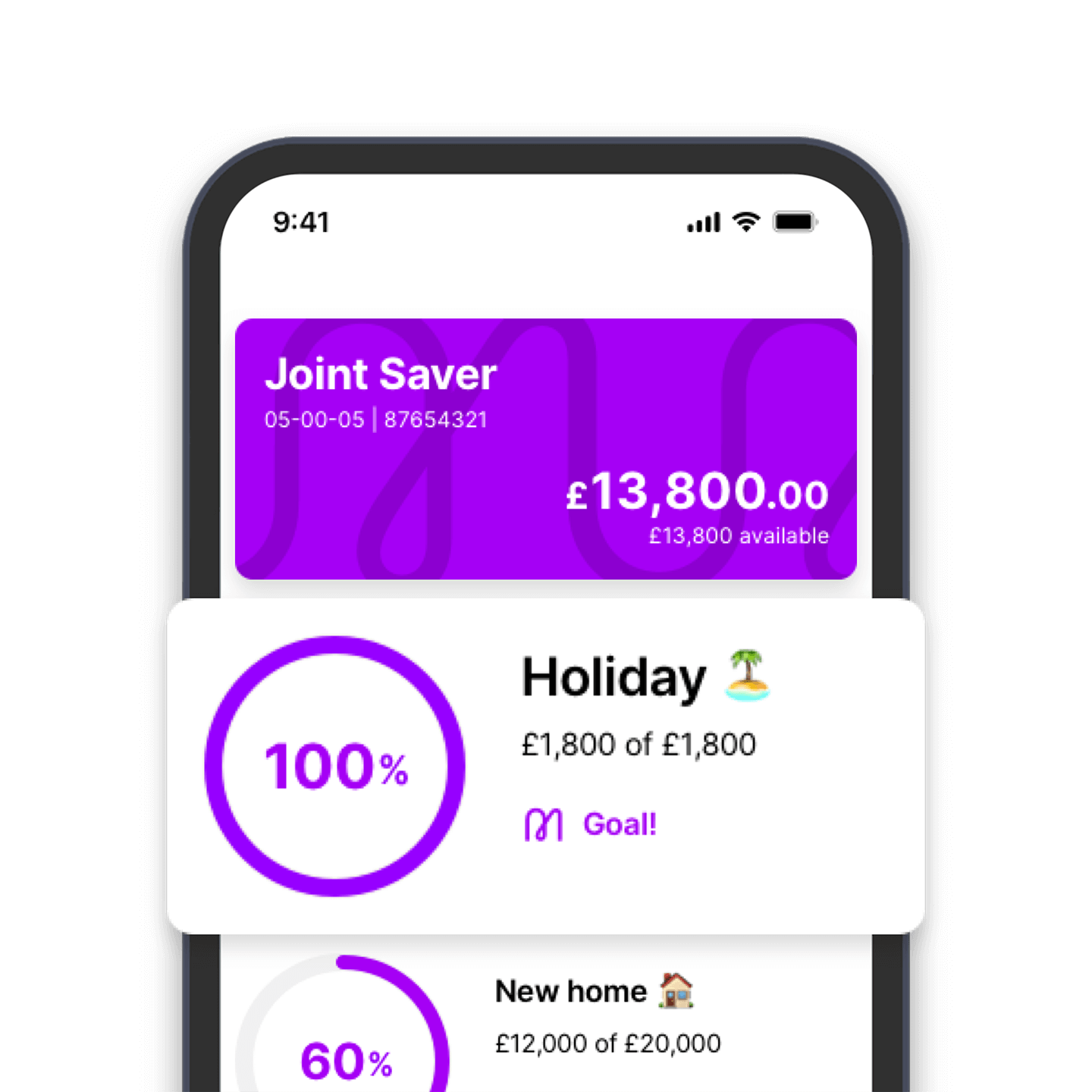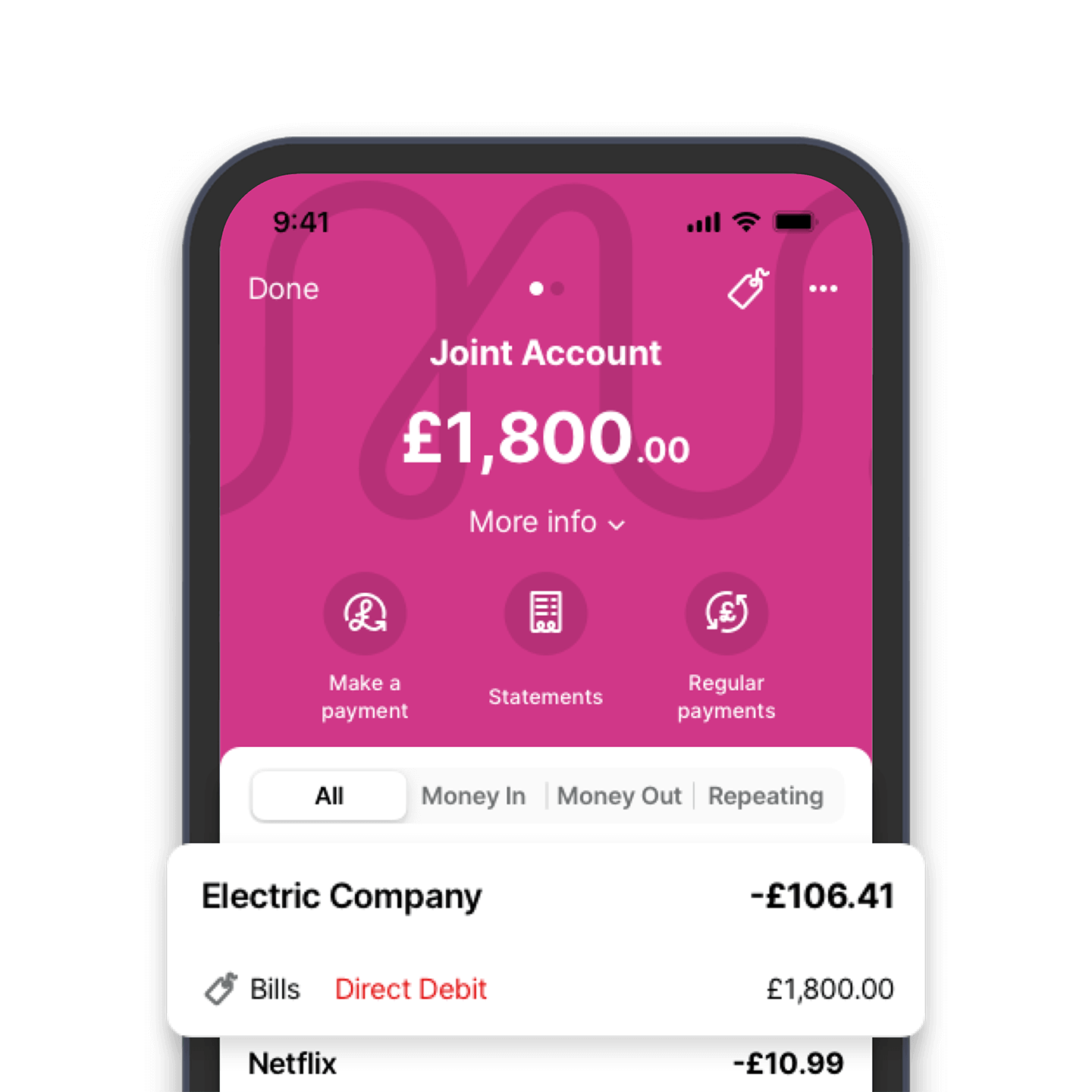What is a joint account?
A joint account is a current account that you share with someone else.
It can make it easier to manage shared expenses and bills. Things like a mortgage, household bills, or the weekly food shop. This could be with your partner, a roommate, or even an elderly relative.
How do they work?
A joint account has the same features as a current account that's just in one name. The difference is that with a joint account, you both have access to the money. So you'll both be able to use the account for things like everyday spending, making payments, and saving.
Both account holders own the money in a joint bank account, so it's important to choose wisely before opening one.

Power up your savings
Saving for a holiday or a new home together? Get a joint current account that comes with a linked savings account.
- Boost your balance with interest on your current account and savings balances
- Set up savings pots in the app to achieve your shared savings goals
- Save on fees. We won't charge you for spending on your card or withdrawing cash when you're abroad. So you know, some cash machines might charge a fee.
Choose a joint account

Everyday bank account
M Plus Account
Our most popular account. It comes with a free linked savings account, access to exclusives and more.
No monthly fee for maintaining the account

Packaged bank account
Club M Account
All the features of our everyday bank account. Plus worldwide family multi-trip travel, mobile and gadget insurance. And breakdown cover.
£12.50 (increasing to £14.00 from 1 February 2026) monthly fee for maintaining the account

Basic bank account
M Account
Great if you have little or no credit history, or non-standard ID. Or you don't qualify for one of our other accounts.
No monthly fee for maintaining the account
Questions about joint accounts
First you and your joint account partner will need to decide whether you want to apply for an M Plus or Club M account. Once that's decided, apply through the M Plus Account or Club M Account page.
You'll both need to enter some personal info. Then we'll digitally verify your identities with a ‘liveness’ selfie and a photo of some ID. Ideally this is a UK driving license but we also accept a valid UK passport or a proof of address document. Find out more about how we verify your identity.
Both joint account holders own the money in a joint bank account. Even if you’ve put different amounts into the account, the money belongs to both joint account holders equally.
When one joint account holder dies, the account will become a sole account and remain active. All payments into or out of the account will continue as normal.
If you go your separate ways and wish to close your joint bank account, we’ll need both parties to agree in writing. You can then divide the money between you. Any overdraft on the account would need to be paid off before you can close the account.
You and your joint account holder need to agree to you being removed and decide how you'll split the money. If you cannot reach an agreement, you may need to take this to court. You can contact us to cancel access to the account. The account will be frozen so no one can use it, including you. We'll only remove your name when you both agree how to split the money.
After you’ve agreed, the process depends on your sort code:
For accounts with a sort code starting 08
Contact us and we’ll sort it all for you.
For accounts with a sort code starting 82 or 05
The joint account will need to be closed, and a new individual account opened in your name. You can’t use the Current Account Switching Service, as it only works between different banks. But don’t worry, we can help move any standing orders and Direct Debits to your new account. You’ll just need to update any incoming payments with your new account details.
Yes, as long as your current account is with another bank that’s part of the Current Account Switch Service. All you have to do is fill out a form and agree a switch date with us. It’ll only take 7 working days to switch and it's covered by the Current Account Switch Guarantee
Using the Current Account Switch Service means everything will be done for you. That includes speaking to your old bank to request the switch and the closure of your old accounts. We'll keep you up to speed with how it's going at all times.
To switch your joint account, give us a call on 0800 678 3654 or +44 141 221 7300 if you're abroad. We're here Monday to Friday, 8am to 6pm and Saturday, 9am to 1pm. Calls may be recorded for training and quality purposes.
A joint bank account works just like an individual bank account, but it’s shared between two people.
You can both make payments, see transactions and manage the account. You’re also both responsible if the account goes into debt.
Having a joint account can make managing bills and shared expenses easier. It can help reduce the mental burden of one person managing their money alone.
You don't need to be married to have a joint account. Some people share current accounts with roommates or friends. It can make managing shared bills and payments easier.
Our packaged account, Club M, may not be right for everyone. You may not be eligible to claim for the insurance benefits that come with your account . To make sure the Club M Account is right for you, please check the Club M Account eligibility.
It depends on what's important to you, what you want to use the account for and how you want to manage your account.
With our joint bank accounts you can get:
- a free linked savings account
- interest on any M Plus or Club M account balance up to £1,000
- cashback when you spend with well-known brands
- access to exclusives, such as a savings account and credit card offers
- no fees when you use your card abroad or shop online in other currencies.
When you’re abroad, some cash machines might charge a fee. - an app to manage your money
At Virgin Money, there are no monthly fees for our "everyday account" (M Plus) or our "basic bank account" (M Account).
If you choose our "packaged account" (Club M), you’ll pay a monthly fee for maintaining the account. You can find the monthly fee and full details in the tariff document.
This account includes:
- Worldwide* family multi-trip travel insurance
* Worldwide cover except travel in, to, or through Cuba, Iran, Syria, North Korea, the Crimea region, or the Donetsk People's Republic (DNR) or Luhansk People's Republic (LNR) regions of Ukraine, or anywhere the Foreign, Commonwealth & Development Office advises against 'all' or 'all but essential' travel. - Worldwide family mobile and gadget insurance
- UK and Europe breakdown cover
Europe includes Andorra, Austria, Balearics, Belgium, Bulgaria, Canary Isles, Channel Islands, Corsica, Croatia, Cyprus, Czech Republic, Denmark, Estonia, Finland, France, Germany, Gibraltar, Greece, Hungary, Italy, Latvia, Liechtenstein, Lithuania, Luxembourg, Malta, Monaco, Netherlands, Norway, Poland, Portugal, Republic of Ireland, Romania, San Marino, Sardinia, Sicily, Slovakia, Slovenia, Spain, Sweden, Switzerland, Turkey in Europe, Üsküdar.
Interest explained
- AER stands for Annual Equivalent Rate, and illustrates what the interest rate would be if interest was paid and compounded once each year.
- Gross is the interest payable without taking account of any tax payable.
- p.a. stands for per annum, which means every year.
- Credit interest is calculated daily on the cleared credit balance in your account.

